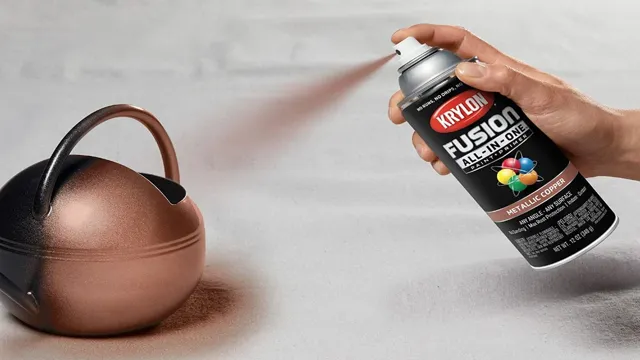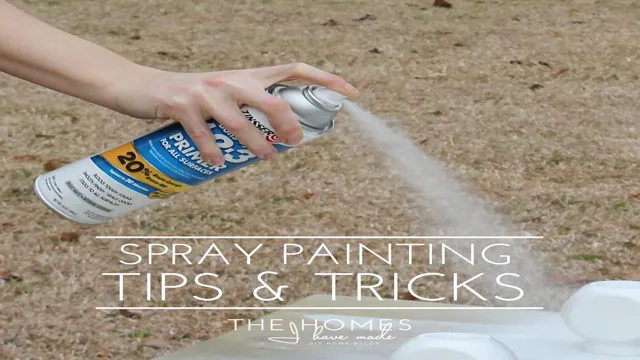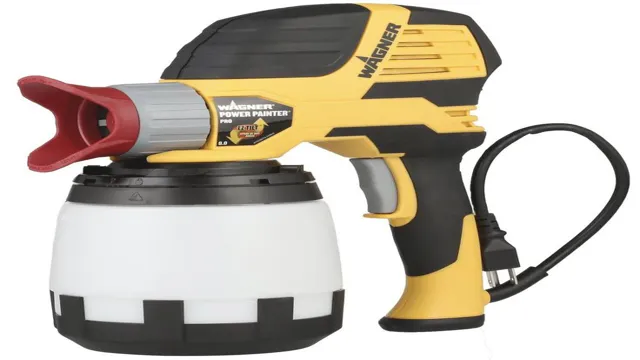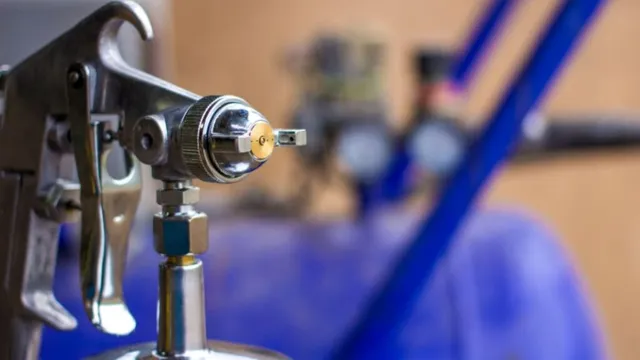Can You Spray Primer Through a Paint Sprayer? Tips and Answers.

As a DIY enthusiast, you may find yourself contemplating whether to use spray paint or brush paint the next time you take on a project. Spraying primer through a paint sprayer is an excellent option that can provide a professional-looking finish to your project. Learning how to do it correctly will save you time, effort, and money in the long run.
Using a paint sprayer allows you to cover a large surface area quickly and evenly, which can be challenging when using a brush or roller. In this blog post, we will discuss how to spray primer through a paint sprayer and provide you with the tips and tricks to achieve an exceptional finish. So, grab a cup of coffee, sit back, and let’s get started!
Introduction
If you’re wondering whether you can spray primer through a paint sprayer, the answer is yes! A paint sprayer is a versatile tool that you can use to spray a wide range of materials, including primer. In fact, using a paint sprayer to apply primer can be more efficient and cost-effective than other methods, such as using a brush or roller. When using a paint sprayer to apply primer, it’s important to choose the right type of primer and ensure that it’s properly thinned and mixed.
Additionally, you’ll want to take the proper safety precautions, such as wearing a respirator and protective clothing, to avoid inhaling any harmful particles. So, whether you’re a DIY enthusiast or a professional painter, using a paint sprayer to apply primer can be an effective way to achieve a smooth, even finish on your surface.
What is primer?
Primer is a substance that is used to prepare surfaces for painting or other types of surface covering by improving their adhesive properties. It is typically composed of a mixture of chemicals that can help to remove dirt, oil, and other contaminants from the surface, as well as improving its ability to hold onto paint or other surface coatings. Primer can be applied to a range of surfaces, including wood, metal, and concrete, and is available in a variety of colors, depending on the intended use.
A good analogy for primer is that it’s like a foundation for makeup – it helps the final product to go on more smoothly and last longer. Whether you’re painting a room, refurbishing an old piece of furniture, or just touching up some scratches, using primer can make a big difference in the final result. So, the next time you’re getting ready to start a home improvement project, don’t forget the primer!

What is a paint sprayer?
A paint sprayer is a tool that is used to apply a coat of paint or other finishes onto surfaces such as walls, ceilings, furniture, and more. Rather than using a brush or roller, a sprayer uses compressed air to atomize the paint into tiny droplets that can be evenly distributed onto surfaces. This creates a smooth and flawless finish that is difficult to achieve with traditional painting methods.
Paint sprayers come in different types and sizes, with handheld models being great for small and intricate jobs while larger models are ideal for bigger projects like painting a house or a commercial building. With a paint sprayer, you can get professional-looking results and save time and effort compared to using traditional painting methods.
Why use a paint sprayer for primer?
Using a paint sprayer for primer may seem like an extra step or a more challenging process than the traditional roller and brush method. However, there are advantages to using a paint sprayer for primer that may make it worth the effort. First and foremost, a paint sprayer can apply primer evenly and smoothly on any surface, making it easier to achieve a consistent and flawless finish.
Additionally, a sprayer can coat large areas quickly, saving you time and effort. Finally, using a sprayer can help you save money on primer as it requires less material due to its fine mist distribution. Overall, using a paint sprayer for primer is a smart choice that can help you achieve professional results quickly and affordably.
Types of primer
A common question among DIY enthusiasts is whether or not they can spray primer through a paint sprayer. The answer is yes, but it depends on the type of primer you’re using. Oil-based primers are thicker and may require thinning before being sprayed through a sprayer.
Water-based primers, on the other hand, are more easily sprayed and don’t require thinning. It’s important to read the manufacturer’s instructions before attempting to spray primer through a paint sprayer to ensure you’re using the correct type and have the right equipment. In general, using a paint sprayer for priming can save time and produce a more even finish, but it’s important to practice proper safety procedures and wear protective gear such as a respirator.
So, yes, spraying primer through a paint sprayer is possible – just make sure you’re using the right type and have the proper equipment and safety precautions in place.
Water-based primer
If you’re planning to paint your walls or any surface, it’s crucial to use a primer. A primer helps the paint adhere to the surface better, improving its durability and overall finish. There are different types of primers available, and one of the popular choices is water-based primer.
This type of primer is easy to use and ideal for surfaces that have light stains or have been previously painted. It also dries quickly, making it ideal for projects that require a shorter turnaround time. One advantage of water-based primer is that it emits less fumes and is less toxic, making it safer to use indoors.
It’s also known for its excellent adhesion, allowing for better durability and ensuring that the paint won’t peel or flake off even after some time. Like any primer, water-based primer can also help cover up imperfections on the surface, ensuring a smoother and more even paint finish. If you’re planning to use water-based primer for your painting project, make sure to select the right type based on your surface and choose high-quality products to achieve the best results.
By using the right primer before painting, you’ll ensure that your paint job will last longer and look better.
Oil-based primer
When it comes to painting, using a primer is essential for achieving a smooth and even finish. There are various types of primers available in the market, each with its unique characteristics and benefits. One of the most commonly used types of primer is an oil-based primer.
This type of primer is excellent for sealing porous surfaces like raw wood or drywall. It also provides superior adhesion, making it an ideal choice for tricky surfaces such as metal or plastic. Moreover, oil-based primer dries slowly, which means it flows better, allowing you to achieve a more refined finish.
However, it’s essential to keep in mind that oil-based primer emits a strong odor and requires solvents to clean up. Thus, it’s crucial to use proper ventilation and take safety precautions while using this type of primer. Overall, choosing the right type of primer is vital for ensuring that your painting project is successful, and oil-based primer can be a great option for certain surfaces.
Shellac-based primer
If you’re looking for a powerful primer that can seal in stains and provide excellent adhesion, a shellac-based primer might be the perfect pick for your project! This type of primer is particularly useful for old woodwork or metal surfaces that have been stained, as it can prevent any remaining stains from bleeding through the paint. Plus, shellac-based primers dry quickly, so you can start painting your topcoat in no time. However, it’s important to keep in mind that shellac-based primers have a very strong odor and can be difficult to clean up, so make sure you use proper ventilation and cleanup techniques.
In short, if you’re looking for a primer that offers outstanding adhesion and stain-blocking capabilities, a shellac-based primer is worth considering.
Types of paint sprayers
Yes, you can spray primer through a paint sprayer. In fact, using a paint sprayer can save you time, effort, and money when it comes to painting surfaces. There are different types of paint sprayers available in the market, including airless sprayers, HVLP sprayers, and compressed air sprayers.
Each type has its own features and advantages, but all of them work well with different types of paint, including primer. Primer is an important coating to apply on surfaces before painting, as it helps to ensure proper adhesion and smoothness of the final coat. Before spraying primer, make sure to prepare the surface by cleaning it thoroughly and sanding any rough spots.
Also, choose the right primer for the type of surface you are painting over and for the type of paint you will apply later. With the right tools and preparation, you can achieve a flawless finish on any surface with a paint sprayer.
Airless paint sprayer
When it comes to painting your home, there are a lot of tools and equipment to consider, and the type of paint sprayer you choose can have a huge impact on the results you achieve. One popular option is an airless paint sprayer, which uses high pressure to atomize the paint and create an even, consistent spray. These sprayers are perfect for large projects as they can cover a lot of area quickly, and they can also be used with a range of different materials, from thick paints to stains and varnishes.
However, it’s important to note that airless paint sprayers can be quite loud and produce a lot of overspray. Plus, they can be a bit more difficult to clean and maintain than other types of sprayers. Overall, if you’re looking for an efficient and versatile paint sprayer that can handle big jobs, an airless paint sprayer might be the right choice for you.
HVLP spray gun
When it comes to painting, choosing the right type of paint sprayer can make a huge difference in achieving a professional finish. One popular option is the HVLP spray gun, which stands for high-volume, low-pressure. This type of sprayer uses compressed air to atomize the paint, producing fine particles that evenly coat the surface.
There are several types of paint sprayers, including airless and conventional, but the HVLP stands out for its ability to minimize overspray and produce a high-quality finish. With an HVLP spray gun, you can achieve a smooth, even coat with minimal effort, making it a popular choice for both DIYers and professionals alike. Whether you’re painting a room in your home or tackling a larger project, an HVLP spray gun can help you achieve that flawless finish you’re looking for.
Compressed air paint sprayer
When it comes to painting, choosing the right paint sprayer can make all the difference in achieving a quality finish. Compressed air sprayers, also known as pneumatic paint sprayers, use compressed air to atomize the paint and apply it evenly over the surface being painted. There are two types of compressed air sprayers: HVLP (high-volume, low-pressure) and conventional.
HVLP sprayers are known for their higher transfer efficiency and reduced overspray, making them an eco-friendly option for painters. Conventional sprayers, on the other hand, are known for their speed and ability to handle thicker paints. No matter which type of compressed air sprayer you choose, make sure to follow proper safety procedures and wear appropriate personal protective equipment.
With the right sprayer and technique, you’ll be able to achieve a flawless finish on your next painting project.
Can you spray primer through a paint sprayer?
Yes, you absolutely can spray primer through a paint sprayer. In fact, many professionals recommend doing so. Using a paint sprayer for primer is an efficient way to cover large surfaces quickly and evenly.
It saves valuable time, ensures a smooth finish, and provides excellent coverage. However, it is important to choose the right type of primer for your sprayer. Some primers are thicker than others and may require thinning before use.
Additionally, make sure to clean your sprayer thoroughly after using it for primer as some primers may be more difficult to remove than others. Overall, using a paint sprayer for primer is a great option for professionals and DIYers alike, as it allows you to achieve a flawless finish in less time. So if you have a paint sprayer at hand, don’t hesitate to try spraying primer with it.
Factors to consider
Yes, you can spray primer through a paint sprayer. However, there are a few factors to consider before doing so. First, ensure that your paint sprayer can handle primer.
Some sprayers are designed specifically for primer, while others may not have the necessary pressure or tip size to handle thicker materials. Additionally, you’ll want to choose the right type of primer for your project, as some may require additional thinning or mixing before being sprayed. It’s also important to properly prepare the surface you’ll be priming, as any imperfections or contaminants can affect the outcome.
By carefully considering these factors, you can achieve a smooth and even primer application using a paint sprayer.
Preparation before spraying primer
When it comes to painting, using a primer is crucial in achieving a high-quality finish. But what if you want to spray on your primer instead of using a brush or roller? The answer is yes, you can definitely spray on your primer through a paint sprayer. However, you need to make sure that your paint sprayer is equipped to handle primers, as some models may not be capable of effectively spraying thicker substances.
In addition, it’s important to properly prepare your surface before spraying on the primer to ensure that it adheres well and creates a smooth finish. This includes cleaning the surface thoroughly, repairing any cracks or holes, and sanding down any rough areas. By taking these precautions and using a reliable paint sprayer, you can achieve a flawless, professional-looking primer coat without breaking a sweat.
How to spray primer through a paint sprayer?
Spraying primer through a paint sprayer can be a great way to cover large areas quickly and easily. The good news is that most paint sprayers are capable of spraying primer as well as paint. However, there are some things you need to keep in mind before you get started.
First, make sure you choose a primer that is compatible with your paint sprayer. Some types of primer may be too thick or too gritty to spray effectively. Second, be sure to thin your primer to the proper consistency before you start spraying.
This will ensure that it flows smoothly through the sprayer without clogging or spitting. Finally, make sure you clean your paint sprayer thoroughly after you finish spraying primer. This will prevent any leftover primer from clogging the sprayer or causing problems the next time you use it.
With these tips in mind, you should have no trouble spraying primer through your paint sprayer and achieving a smooth, even finish on your project.
Conclusion
In conclusion, the answer to the question of whether you can spray primer through a paint sprayer is a resounding yes! After all, why limit yourself to just one type of coating when you can use a primer to promote adhesion, protect against rust, and prime the surface all at once? So go ahead and prime away, knowing that with your trusty sprayer in hand, the only limit to your painting prowess is your own imagination (and maybe the amount of primer you have on hand). Happy spraying!”
FAQs
What is primer and why is it important in painting?
Primer is a preparatory coating that is applied to a surface before painting. It helps improve the adhesion of paint to the surface, covers up any stains or imperfections, and provides a first layer of protection. It is important because it ensures a smooth and even base for the paint to adhere to, leading to a longer-lasting and more durable finish.
What is the best type of paint sprayer for applying primer?
The best type of paint sprayer for applying primer is an airless sprayer. These sprayers are designed to handle thicker coatings like primer, and can deliver a large amount of paint quickly and evenly. However, it is important to choose the right tip size and pressure setting to ensure proper atomization and coverage.
Can you use a paint sprayer to apply primer directly on bare wood?
Yes, you can use a paint sprayer to apply primer directly on bare wood. However, it is important to first clean and prep the surface properly, as bare wood can be porous and absorbent. You may also need to apply multiple coats of primer to achieve the desired coverage.
Do you need to thin primer before spraying it through a paint sprayer?
It depends on the type of primer and the sprayer you are using. Some primers come ready-to-spray, while others may require thinning with a compatible solvent or thinning agent. It is important to read the manufacturer’s instructions and recommendations before attempting to spray primer through a paint sprayer.
Can you spray oil-based primer through a paint sprayer?
Yes, you can spray oil-based primer through a paint sprayer. However, oil-based products can be thicker and more viscous than water-based products, so you may need to use a larger tip size and higher pressure setting on your sprayer. It is also important to clean the sprayer thoroughly after use, as oil-based products can be more difficult to clean up than water-based products.
How do you clean a paint sprayer after spraying primer?
To clean a paint sprayer after spraying primer, you should first empty any remaining primer from the hopper or container. Next, flush the sprayer with a compatible solvent or cleaning solution, using the appropriate cleaning cycle or method for your specific sprayer. You may also need to disassemble some parts of the sprayer and clean them separately, using a brush or other cleaning tool.
Can you reuse leftover primer in a paint sprayer?
Yes, you can reuse leftover primer in a paint sprayer, as long as it has been stored properly and has not dried or become contaminated. However, you may need to thin the primer or stir it thoroughly before using it again, as settling or separation may occur over time. It is also important to strain the primer through a fine mesh filter before spraying it again, to remove any particles or debris that may have accumulated.



